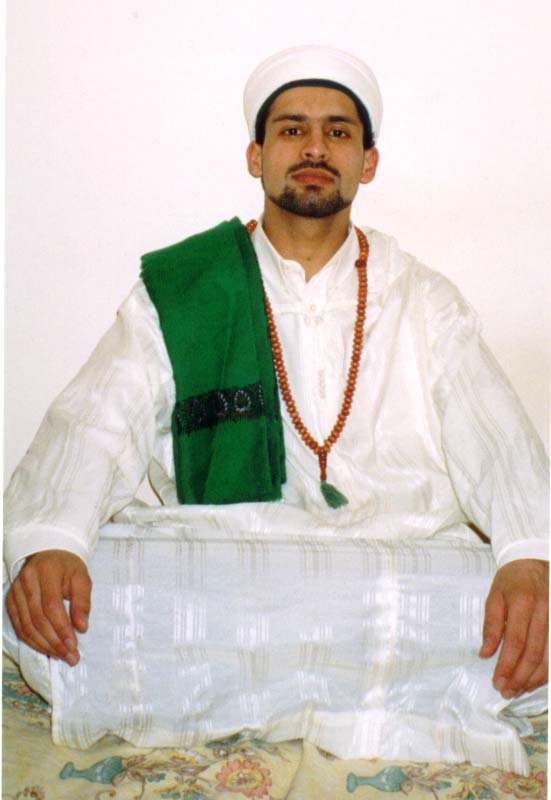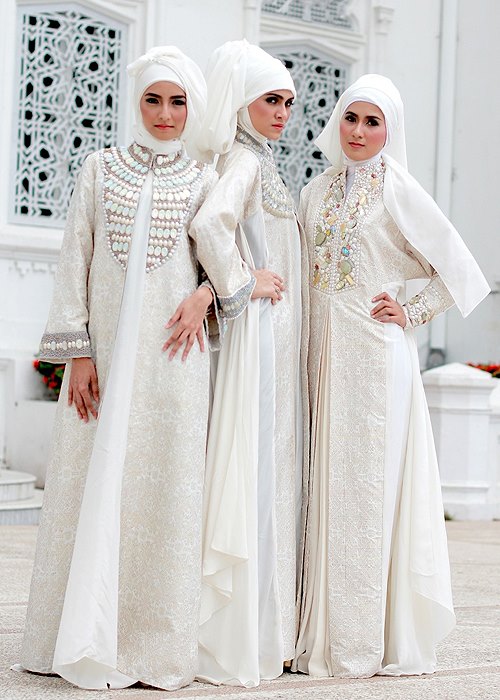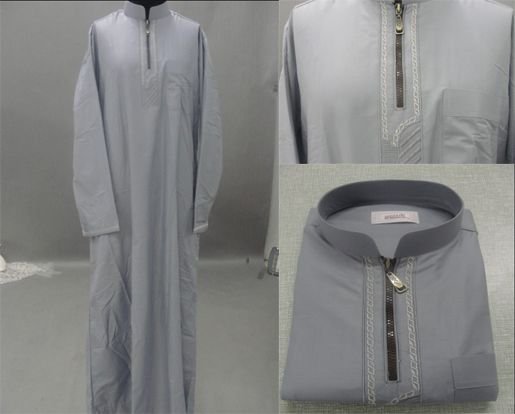About Arabic Clothing
Source (google.com.pk)
The Arabic word hijab has a literal translation into the word “veil”.[1] Adherents of Islam believe that it was originally implemented by Allah in order to secure Mohammed’s privacy and create a distinction between the public and private spheres of his life.[2] The word hijab applied to both men and women in terms of protecting both their private lives from outsiders and to protect one's own honor, not in specific relation to one's sexual activity or desires [1]
Muslims are concerned with clothing in two contexts: clothing for everyday wear, inside and outside the house; and clothing required in specifically religious contexts.
Say to the believing men that they should lower their gaze and guard their modesty: that will make for greater purity for them: And Allah is well acquainted with all that they do. And say that the believing women that they should lower their gaze and guard their modesty that they should not display their beauty and ornaments except what (must ordinarily) appear thereof; that they should draw their veils over their bosoms and not display their beauty except to their husbands, their fathers, their husband's fathers, their sons, their husbands' sons, their brothers or their brothers' sons, or their sisters' sons, or their women, or the slaves whom their right hands possess, or male servants free of physical needs, or small children who have no sense of the shame of sex; and that they should not strike their feet in order to draw attention to their hidden ornaments. And O ye Believers! turn ye all together towards Allah, that ye may attain Bliss.
—Sura 24 (An-Nur), ayat 30-31, Qur'an[3]
O Prophet! Tell thy wives and thy daughters and the women of the believers to draw their cloaks close round them. That will be better, so that they may be recognized and not harassed. Allah is ever Forgiving, Merciful.
—Sura 33 (Al-Ahzab), ayah 59, Qur'an[4]
However, there are many different interpretations of what "modesty" requires. The Quran admonishes Muslim women to dress modestly and cover their breasts and genitals.[5] The Quran explicitly states that "O wives of the Prophet, you are not like anyone among women" (Quran 33: 32) and as such has separate rules specifically for the wives of the Prophet.[6] However, many people often mistake it for rules for all Muslim women.[6] The Quran has no requirement that women cover their faces with a veil, or cover their bodies with the full-body burqua or chador.[7] The Qur'an does not mandate or mention Hijab.[6][8]
The veil re-emerged as a topic of conversation in the 1990s when there was a legitimate concern regarding potential western infiltration of Muslim practices in Islamic countries.[9] The veil had a new purpose of shielding Muslim women from western influence. There were several religious leaders that reinforced that an additional purpose of the hijab was to protect the Islamic people and customs.
Muslim women by Islamic dress code, wearing hijab and niqab.
Main article: Islamic dress in Europe
Islamic dress in Europe, notably the variety of headdresses worn by Muslim women, has become a prominent symbol of the presence of Islam in western Europe. In several countries the adherence to hijab (an Arabic noun meaning "to cover") has led to political controversies and proposals for a legal ban. The Netherlands government has decided to introduce a ban on face-covering clothing, popularly described as the "burqa ban", although it does not only apply to the Afghan-model burqa. Other countries, such as France are debating similar legislation, or have more limited prohibitions. Some of them apply only to face-covering clothing such as the burqa, chador, boushiya, or niqab; some apply to any clothing with an Islamic religious symbolism such as the khimar, a type of headscarf (some countries already have laws banning the wearing of masks in public, which can be applied to veils that conceal the face). The issue has different names in different countries, and "the veil" or "hijab" may be used as general terms for the debate, representing more than just the veil itself, or the concept of modesty embodied in hijab.
Although the Balkans and Eastern Europe have Indigenous Muslim populations, most Muslims in western Europe are members of immigrant communities. The issue of Islamic dress is linked with issues of immigration and the position of Islam in western society. European Commissioner Franco Frattini said in November 2006, that he did not favour a ban on the burqa.[10] This is apparently the first official statement on the issue of prohibition of Islamic dress from the European Commission, the executive of the European Union. The reasons given for prohibition vary. Legal bans on face-covering clothing are often justified on security grounds, as an anti-terrorism measure.[11][12]
Ayaan Hirsi Ali sees Islam as incompatible with Western values, at least in its present form. She advocates the values of 'Enlightenment liberalism', including secularism and equality of women. For her, the burqa or chador are both a symbol of religious obscurantism and the oppression of women. Western Enlightenment values, in her view, require prohibition, regardless of whether a woman has freely chosen Islamic dress. Islamic dress is also seen as a symbol of the existence of parallel societies, and the failure of integration: in 2006 British Prime Minister Tony Blair described it as a "mark of separation".[13] Visible symbols of a non-Christian culture conflict with the national identity in European states, which assumes a shared (non-religious) culture. Proposals for a ban may be linked to other related cultural prohibitions: the Dutch politician Geert Wilders proposed a ban on hijabs, in Islamic schools, in new mosques, and in non-western immigration.
In France and Turkey, the emphasis is on the secular nature of the state, and the symbolic nature of the Islamic dress, and bans apply at state institutions (courts, civil service) and in state-funded education. These bans also cover Islamic headscarves, which in some other countries are seen as less controversial, although law court staff in the Netherlands are also forbidden to wear Islamic headscarves on grounds of 'state neutrality'. An apparently less politicised argument is that in specific professions (teaching), a ban on "veils" (niqab) is justified, since face-to-face communication and eye contact is required. This argument has featured prominently in judgements in Britain and the Netherlands, after students or teachers were banned from wearing face-covering clothing. Public and political response to such prohibition proposals is complex, since by definition they mean that the government decides on individual clothing. Some non-Muslims, who would not be affected by a ban, see it as an issue of civil liberties, as a slippery slope leading to further restrictions on private life. A public opinion poll in London showed that 75 percent of Londoners support "the right of all persons to dress in accordance with their religious beliefs".[14] In another poll in the United Kingdom by Ipsos MORI, 61 percent agreed that "Muslim women are segregating themselves" by wearing a veil, yet 77 percent thought they should have the right to wear it.
Arabic Clothing Abaya Designs 2014 Dress Collection Dubai Styles Fashion Pics Photos Images Wallpapers

Arabic Clothing Abaya Designs 2014 Dress Collection Dubai Styles Fashion Pics Photos Images Wallpapers
.jpg)
Arabic Clothing Abaya Designs 2014 Dress Collection Dubai Styles Fashion Pics Photos Images Wallpapers

Arabic Clothing Abaya Designs 2014 Dress Collection Dubai Styles Fashion Pics Photos Images Wallpapers

Arabic Clothing Abaya Designs 2014 Dress Collection Dubai Styles Fashion Pics Photos Images Wallpapers

Arabic Clothing Abaya Designs 2014 Dress Collection Dubai Styles Fashion Pics Photos Images Wallpapers

Arabic Clothing Abaya Designs 2014 Dress Collection Dubai Styles Fashion Pics Photos Images Wallpapers

Arabic Clothing Abaya Designs 2014 Dress Collection Dubai Styles Fashion Pics Photos Images Wallpapers

Arabic Clothing Abaya Designs 2014 Dress Collection Dubai Styles Fashion Pics Photos Images Wallpapers

Arabic Clothing Abaya Designs 2014 Dress Collection Dubai Styles Fashion Pics Photos Images Wallpapers

Arabic Clothing Abaya Designs 2014 Dress Collection Dubai Styles Fashion Pics Photos Images Wallpapers

Arabic Clothing Abaya Designs 2014 Dress Collection Dubai Styles Fashion Pics Photos Images Wallpapers

Arabic Clothing Abaya Designs 2014 Dress Collection Dubai Styles Fashion Pics Photos Images Wallpapers

Arabic Clothing Abaya Designs 2014 Dress Collection Dubai Styles Fashion Pics Photos Images Wallpapers

Arabic Clothing Abaya Designs 2014 Dress Collection Dubai Styles Fashion Pics Photos Images Wallpapers

Arabic Clothing Abaya Designs 2014 Dress Collection Dubai Styles Fashion Pics Photos Images Wallpapers

Arabic Clothing Abaya Designs 2014 Dress Collection Dubai Styles Fashion Pics Photos Images Wallpapers

Arabic Clothing Abaya Designs 2014 Dress Collection Dubai Styles Fashion Pics Photos Images Wallpapers

Arabic Clothing Abaya Designs 2014 Dress Collection Dubai Styles Fashion Pics Photos Images Wallpapers

Arabic Clothing Abaya Designs 2014 Dress Collection Dubai Styles Fashion Pics Photos Images Wallpapers

Arabic Clothing Abaya Designs 2014 Dress Collection Dubai Styles Fashion Pics Photos Images Wallpapers

Arabic Clothing Abaya Designs 2014 Dress Collection Dubai Styles Fashion Pics Photos Images Wallpapers

No comments:
Post a Comment